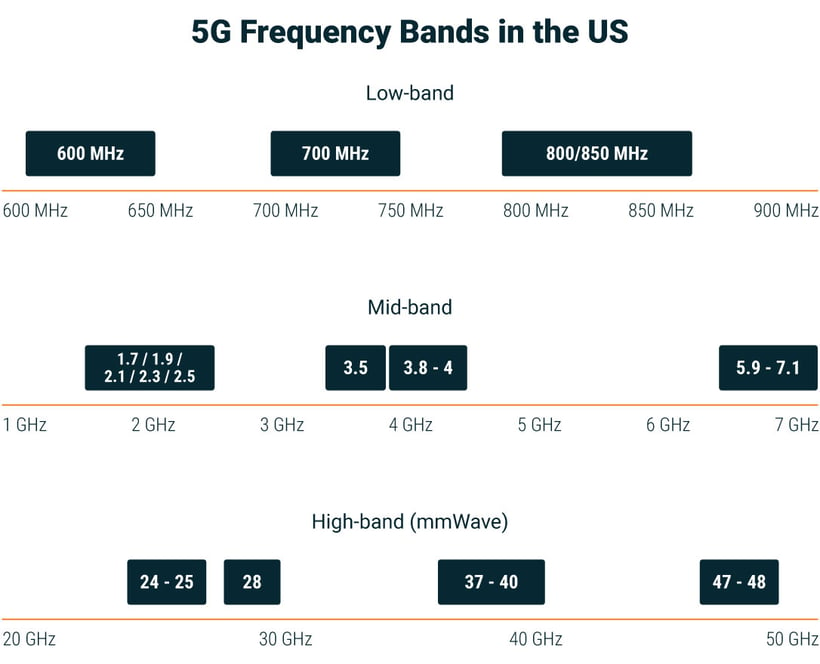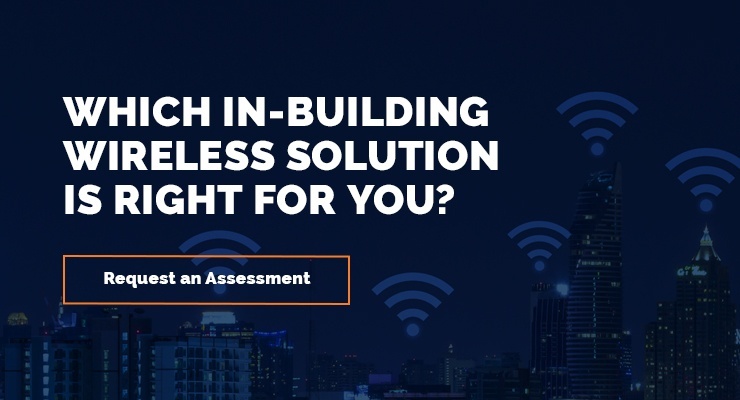5G is revolutionizing in-building coverage by providing higher data speeds, massive network capacity, lower latency, and greater bandwidth to support the abundant IoT devices of today.
To successfully leverage the benefits of 5G, Facility Managers need to understand the 5G landscape and the impact of 5G on distributed antenna systems (DAS). The more knowledge Facility Managers have, the easier it will be to make informed decisions regarding whether to upgrade their existing DAS or invest in building new ones entirely.
From 5G DAS signal sources to the various types of 5G frequency bands, here is everything Facility Managers need to know about 5G DAS.
Why DAS Technology is Essential for In-Building 5G Coverage
Cell towers provide adequate 5G coverage outdoors, but what about indoor coverage? Since more than 80% of voice and data usage occurs indoors, Facility Managers need a wireless solution that distributes reliable cellular coverage for the entire facility and connecting campus buildings. It is critical that not only common areas but all known dead zones within a given building are able to receive a signal.
When implemented correctly, 5G can work as well indoors as 4G LTE, but there are various challenges building owners need to be aware of. For example, certain building materials such as metal, concrete, and glass interfere with cell towers and prevent signals from penetrating venues. Low-emissivity (low-E) glass, a building material used in newer buildings, LEEDs, and Green Building initiatives, also interfere with radio frequency (RF) signals.
The issue of cell signal penetration applies to all types of cellular signals, but since 5G is often deployed on higher frequencies, the problem of signal penetration is exacerbated even more than 3G and 4G. Fortunately, 5G DAS is designed to fix this issue by distributing 5G indoors to areas where the signal from outdoor 5G cell towers can’t reach, ensuring indoor 5G coverage that is as good or even better than outdoors.
What is 5G DAS?
Before diving into 5G DAS, building owners and Facility Managers need a preliminary understanding of indoor Distributed Antenna Systems (DAS). Indoor DAS or iDAS is a network of antennas that send and receive cellular signals on a carrier’s licensed frequency.
Indoor DAS technology improves cellular coverage and capacity for any area where building materials or the number of users interrupt superior cellular voice and data services. This includes high population density areas and isolated areas that cannot be effectively addressed with traditional sites such as stairwells and basements. Indoor DAS is commonly implemented to provide wireless coverage in:
- Hotels
- Logistics and industrial facilities
- Corporate buildings and flex spaces
- Hospitals and healthcare facilities
- Universities and campus environments
The main difference between previous iterations of indoor DAS technology and a 5G DAS is the ability to support the distribution of 5G “New Radio” signals. DAS tailored for 5G compatibility will typically support newer frequency bands including T-Mobile's n41 band and n77 C-Band frequencies.
A future-proofed 5G DAS leverages modularity to enable the system to adapt to new frequency allocations and technology generations, like 5G. A modular approach to DAS infrastructure helps businesses and venue owners protect their investment from future technological changes by enabling incremental changes and helping to avoid “rip and replace” scenarios.
Understanding 5G DAS Signal Sources
All DAS systems require two main components: a signal source and a distribution system. For 5G DAS deployment, venue owners should be aware of two primary types of signal sources: small cells and off-air. Since each signal source has unique pros and cons, building owners should consult experienced DAS specialists to discuss the right signal source option for their facility based on their venue’s connectivity needs and budget.
5G Small Cells - Also referred to as gNodeBs, 5G small cells use dedicated fiber or an internet connection to connect back to the operator’s core network.
Off-Air 5G Signal Source - An off-air 5G signal source leverages a “donor” antenna to receive signals from the nearest cell tower. "Donor" antennas are typically installed on the roof of a building. It is important to note that the performance of an off-air system is contingent upon the availability and quality of the outdoor 5G cell signal.
Understanding the Three Types of 5G
Differing from 4G/LTE where frequency bands share similar characteristics, 5G frequency ranges offer different speeds and limitations. Venue owners that are well versed in 5G are better positioned to deploy a 5G DAS solution that supports most of the spectrum and continuously meets their facility’s connectivity requirements at a lower cost.
Here is a brief overview of the types of 5G frequency bands. They are broken down into three categories: high-band, mid-band, and low-band.
Low-band 5G - The lowest tier of 5G frequency bands travel the farthest but have the most limited speed compared to the other categories. Low-band 5G is commonly used to achieve coverage in rural areas. Low-band 5G frequencies range from 600 MHz, 800 MHz, and 900MHz bands.
Mid-band 5G - Thought of as a balance between low and high-band 5G, the middle tier of 5G frequency bands don’t provide the same low latency and high-speeds associated with high-band but provide a signal that is more resilient and has better propagation. Mid-band 5G frequencies are commonly used to provide coverage and capacity in urban and suburban areas and range from 1 GHz to 6 GHz.
High-band 5G - Also referred to as millimeter wave (mmWave) 5G, high-band 5G offers huge capacity, speed, and low latency. High-band 5G frequencies include 24GHz, 28GHz, and the upper 37GHz, 39GHz, and 47GHz bands. It is important to note that these bands travel very short distances and are easily hindered by man-made and natural barriers including metal, brick, low emission glass, rain, and vegetation.

Remember, all 5G is not created equal as each frequency range offers different speeds and limitations. For the best combination of coverage, performance, and price, major carriers recommend mid-band 5G for in-building DAS deployments as they offer plenty of capacity and can still transmit through windows and drywall.
Does 5G Require Additional DAS Infrastructure Development?
The short answer is yes as 5G uses different wavelengths than 4G. Whether a building owner needs to upgrade their existing DAS infrastructure or replace the system entirely depends on the specifics of the installed equipment.
Building owners and Facility Managers can upgrade their existing DAS if their 4G system is modular and the vendor has released modules to support new 5G frequencies. A few non-modular off-air distributed antenna systems can be upgraded via software updates to support 5G on existing frequency bands. However, these systems will not support newer 5G bands unless the original equipment supports those frequencies.
From a financial and performance perspective, it may make more sense to replace a DAS even if the option to upgrade an existing system is available. It is important to note that 5G performance is significantly better when it’s installed in a DAS that supports 2x2 and 4x4 MIMO (Multiple-Input, Multiple-Output), which is typically not the case for older distributed antenna systems.
Get Ready to Future-Proof Your DAS for 5G
Distributed antenna systems are complex but the more 5G knowledge venue owners have, the better positioned they will be to partner with an experienced DAS integrator to successfully deploy a 5G DAS solution, whether that entails installing a new system or upgrading an existing DAS. The right systems integrator will work with building owners to choose the solution that best fits the unique connectivity requirements of their facility to ensure a successful deployment.





